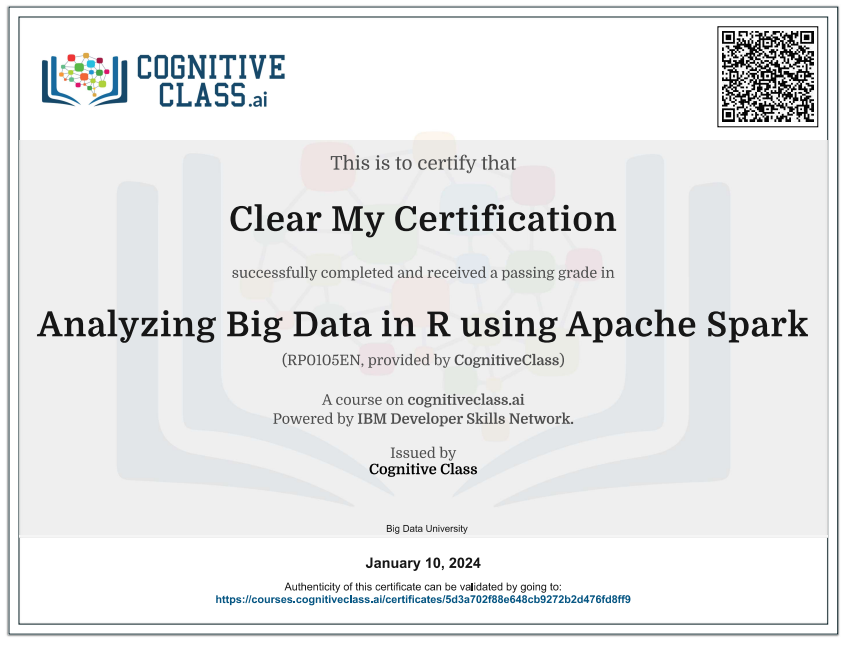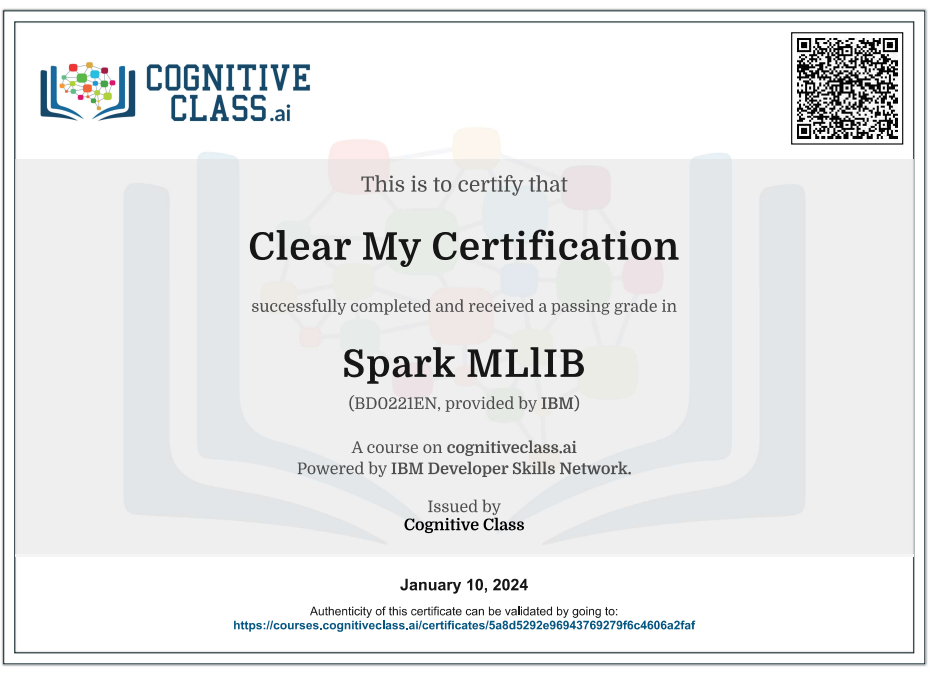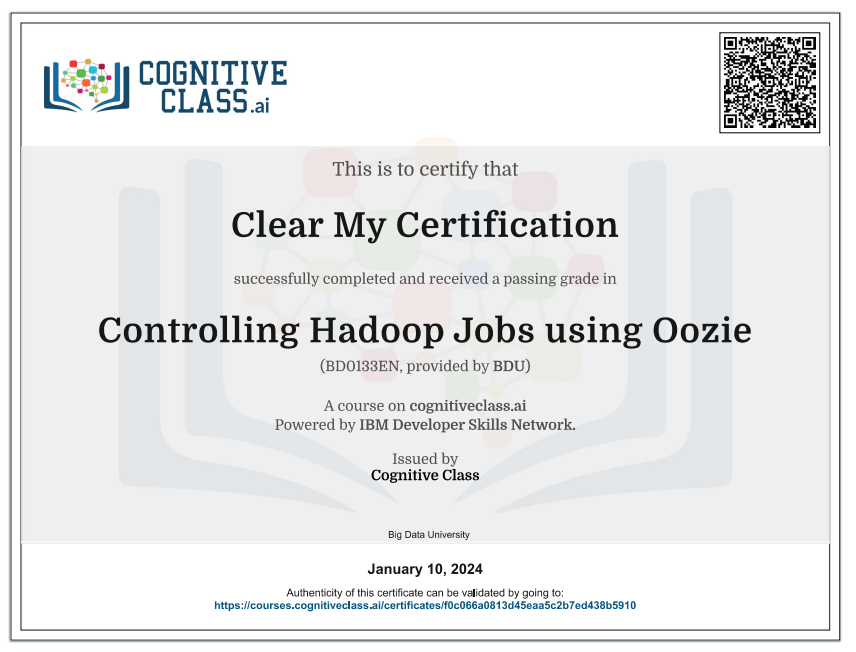Enroll Here: Machine Learning with Python Cognitive Class Exam Quiz Answers
Machine Learning with Python Cognitive Class Certification Answers

Module 1 – Machine Learning Quiz Answers – Cognitive Class
Question 1: Machine Learning uses algorithms that can learn from data without relying on explicitly programmed methods.
- True
- False
Question 2: Which are the two types of supervised learning techniques?
- Classification and Clustering
- Classification and K-Means
- Regression and Clustering
- Regression and Partitioning
- Classification and Regression
Question 3: Which of the following statements best describes the Python scikit library?
- A library for scientific and high-performance computation.
- A collection of algorithms and tools for machine learning.
- A popular plotting package that provides 2D plotting as well as 3D plotting.
- A library that provides high-performance, easy to use data structures.
- A collection of numerical algorithms and domain-specific toolboxes.
Module 2 – Regression Quiz Answers – Cognitive Class
Question 1: Training and testing on the same dataset might have a high training accuracy, but its out-of-sample accuracy might be low.
- True
- False
Question 2: If the correlation coefficient is 0.7 or lower, it may be appropriate to fit a non-linear regression.
- True
- False
Question 3: When we should use Multiple Linear Regression?
- When we would like to identify the strength of the effect that the independent variables have on a dependent variable.
- When there are multiple dependent variables.
Module 3 – Classification Quiz Answers – Cognitive Class
Question 1: In K-Nearest Neighbors, which of the following is true:
- A very high value of K (ex. K = 100) produces an overly generalised model, while a very low value of k (ex. k = 1) produces a highly complex model.
- A very high value of K (ex. K = 100) produces a model that is better than a very low value of K (ex. K = 1)
- A very high value of k (ex. k = 100) produces a highly complex model, while a very low value of K (ex. K = 1) produces an overly generalized model.
Question 2: A classifier with lower log loss has better accuracy.
- True
- False
Question 3: When building a decision tree, we want to split the nodes in a way that decreases entropy and increases information gain.
- True
- False
Module 4 – Clustering Quiz Answers – Cognitive Class
Question 1: Which one is NOT TRUE about k-means clustering??
- K-means divides the data into non-overlapping clusters without any cluster internal structure.
- The objective of k-means is to form clusters in such a way that similar samples go into a cluster and dissimilar samples fall into different clusters.
- As k-means is an iterative algorithm, it guarantees that it will always converge to the global optimum.
Question 2: Customer segmentation is a supervised way of clustering data based on the similarity of customers to each other.
- True
- False
Question 3: How is a center point (centroid) picked for each cluster in k-means?
- We can randomly choose some observations out of the dataset and use these observations as the initial means.
- We can select the centroid through correlation analysis.
Module 5 – Recommender Systems Quiz Answers – Cognitive Class
Question 1: Collaborative filtering is based on relationships between products and people’s rating patterns.
- True
- False
Question 2: Which one is TRUE about content-based recommendation systems?
- Content-based recommendation system tries to recommend items to the users based on their profile.
- In content-based approach, the recommendation process is based on similarity of users.
- In content-based recommender systems, similarity of users should be measured based on the similarity of the actions of users.
Question 3: Which one is correct about user-based and item-based collaborative filtering?
- In the item-based approach, the recommendation is based on the profile of a user that shows interest in a specific item.
- In the user-based approach, the recommendation is based on users of the same neighborhood, with whom he/she shares common preferences.
Machine Learning with Python Final Exam Answers – Cognitive Class
Question 1: You can define Jaccard as the size of the intersection divided by the size of the union of two label sets.
- True
- False
Question 2: When building a decision tree, we want to split the nodes in a way that increases entropy and decreases information gain.
- True
- False
Question 3: Which of the following statements are true? (Select all that apply.)
- K needs to be initialized in K-Nearest Neighbor.
- Supervised learning works on labelled data.
- A high value of K in KNN creates a model that is over-fit.
- KNN takes a bunch of unlabelled points and uses them to predict unknown points.
- Unsupervised learning works on unlabelled data.
Question 4: To calculate a model’s accuracy using the test set, you pass the test set to your model to predict the class labels, and then compare the predicted values with actual values.
- True
- False
Question 5: Which is the definition of entropy?
- The purity of each node in a decision tree.
- Information collected that can increase the level of certainty in a particular prediction.
- The information that is used to randomly select a subset of data.
- The amount of information disorder in the data.
Question 6: Which of the following is true about hierarchical linkages?
- Average linkage is the average distance of each point in one cluster to every point in another cluster.
- Complete linkage is the shortest distance between a point in two clusters.
- Centroid linkage is the distance between two randomly generated centroids in two clusters.
- Single linkage is the distance between any points in two clusters.
Question 7: The goal of regression is to build a model to accurately predict the continuous value of a dependent variable for an unknown case.
- True
- False
Question 8: Which of the following statements are true about linear regression? (Select all that apply)
- With linear regression, you can fit a line through the data.
- y=a+b_x1 is the equation for a straight line which can be used to predict the continuous value y.
- In y=θ^T.X, θ is the feature set and X is the “weight vector” or “confidences of the equation”, with both of these terms used interchangeably.
Question 9: The Sigmoid function is the main part of logistic regression, where Sigmoid of 0^T.X gives us the probability of a point belonging to a class, instead of the value of y directly.
- True
- False
Question 10: In comparison to supervised learning, unsupervised learning has:
- Less tests (evaluation approaches)
- More models
- A better, controlled environment
- More tests (evaluation approaches), but less models
Question 11: The points that are classified by Density-Based Clustering and do not belong to any cluster are outliers.
- True
- False
Question 12: Which of the following is false about Simple Linear Regression?
- It does not require tuning parameters.
- It is highly interpretable.
- It is fast.
- It is used for finding outliers.
Question 13: Which one of the following statements is the most accurate?
- Machine Learning is the branch of AI that covers the statistical and learning part of artificial intelligence.
- Deep Learning is a branch of Artificial Intelligence where computers learn by being explicitly programmed.
- Artificial Intelligence is a branch of Machine Learning that covers the statistical part of Deep Learning.
- Artificial Intelligence is the branch of Deep Learning that allows us to create models.
Question 14: Which of the following are types of supervised learning?
- Classification
- Regression
- KNN
- K-Means
- Clustering
Question 15: A bottom-up version of hierarchical clustering is known as divisive clustering. It is a more popular method than the Agglomerative method.
- True
- False
Question 16: Select all the true statements related to Hierarchical clustering and K-Means:
- Hierarchical clustering does not require the number of clusters to be specified.
- Hierarchical clustering always generates different clusters, whereas k-Means returns the same clusters each time it is run.
- K-Means is more efficient than Hierarchical clustering for large datasets.
Question 17: What is a content-based recommendation system?
- Content-based recommendation system tries to recommend items to the users based on their profile built upon their preferences and taste.
- Content-based recommendation system tries to recommend items based on similarity among items.
- Content-based recommendation system tries to recommend items based on the similarity of users when buying, watching, or enjoying something.
Question 18: Before running Agglomerative clustering, you need to compute a distance/proximity matrix, which is an n by n table of all distances between each data point in each cluster of your dataset.
- True
- False
Question 19: Which of the following statements are true about DBSCAN? (Select all that apply.)
- DBSCAN can be used when examining spatial data.
- DBSCAN can be applied to tasks with arbitrary shaped clusters, or clusters within clusters.
- DBSCAN is a hierarchical algorithm that finds core and border points.
- DBSCAN can find any arbitrary shaped cluster without getting affected by noise.
Question 20: In recommender systems, a “cold start” happens when you have a large dataset of users who have rated only a limited number of items.
- True
- False
Introduction to Machine Learning with Python
Machine learning with Python involves using Python programming language and its various libraries and frameworks to implement and apply machine learning algorithms. Python has become one of the most popular programming languages for machine learning due to its simplicity, versatility, and the availability of a rich ecosystem of libraries and tools. Here’s an overview of key components and steps involved in machine learning with Python:
- Libraries and Frameworks:
- NumPy and Pandas: Essential libraries for numerical computing and data manipulation.
- Scikit-learn: A comprehensive machine learning library that provides tools for classification, regression, clustering, and more.
- Matplotlib and Seaborn: Libraries for data visualization.
- TensorFlow and PyTorch: Deep learning frameworks widely used for building and training neural networks.
- Data Preparation:
- Data Collection: Gather relevant datasets for your machine learning task.
- Data Cleaning: Handle missing values, outliers, and inconsistencies.
- Feature Engineering: Create new features or transform existing ones to improve model performance.
- Data Splitting: Divide the dataset into training and testing sets to evaluate the model’s performance on unseen data.
- Choosing a Model: Select a machine learning algorithm or model based on the nature of the task (classification, regression, clustering) and the characteristics of the data.
- Model Training: Use the training dataset to teach the model by adjusting its parameters to minimize the difference between predicted and actual outcomes.
- Model Evaluation: Assess the model’s performance using the testing dataset. Common evaluation metrics include accuracy, precision, recall, F1 score (for classification tasks), and mean squared error (for regression tasks).
- Hyperparameter Tuning: Optimize the model’s hyperparameters to improve its performance. Grid search and random search are common techniques for hyperparameter tuning.
- Model Deployment: Implement the trained model into a production environment for making predictions on new, unseen data.
- Continuous Improvement: Monitor the model’s performance over time and update it as needed. Re-train the model with new data to adapt to changing patterns.
 Clear My Certification All Certification Exam Answers
Clear My Certification All Certification Exam Answers



